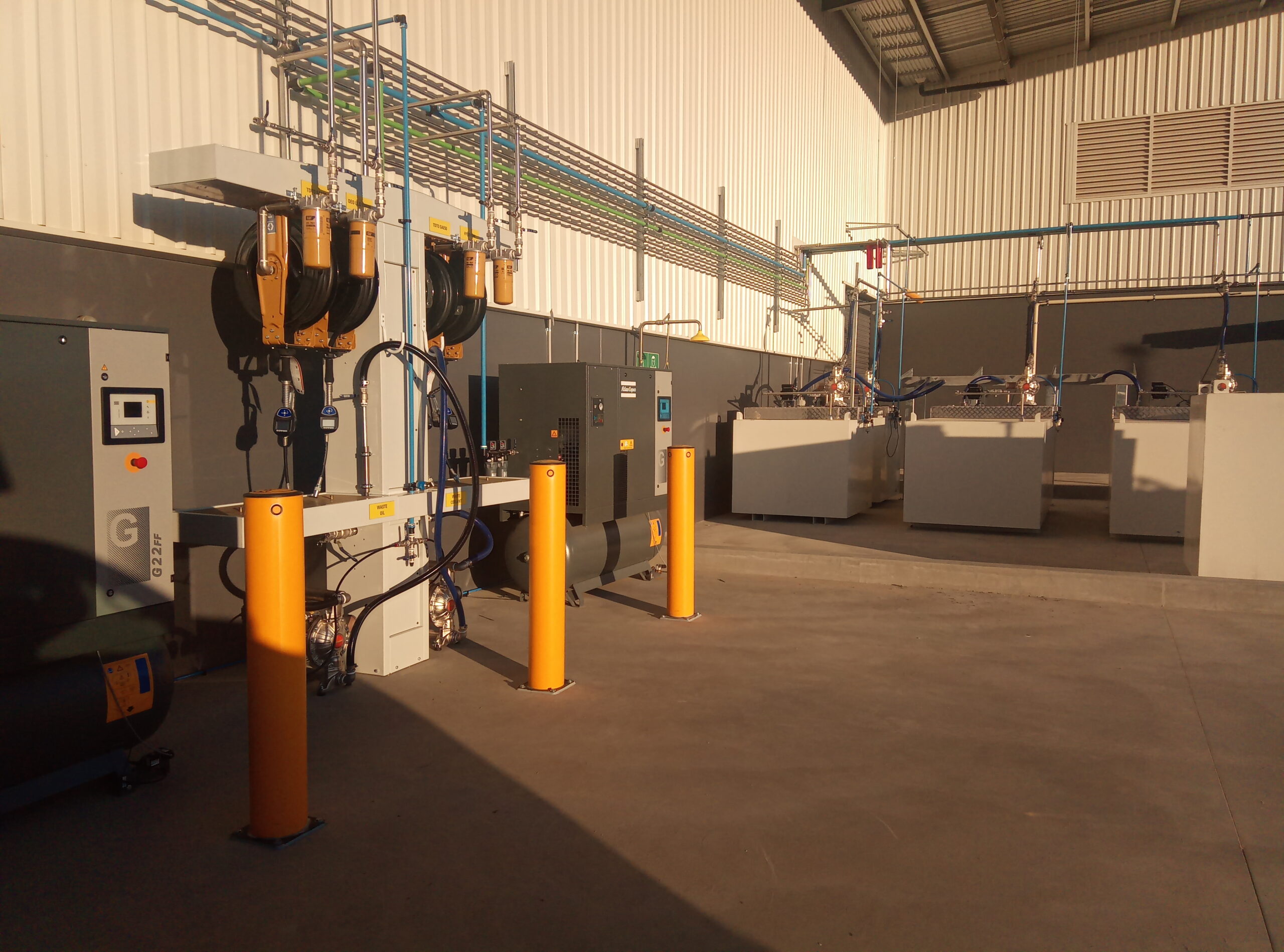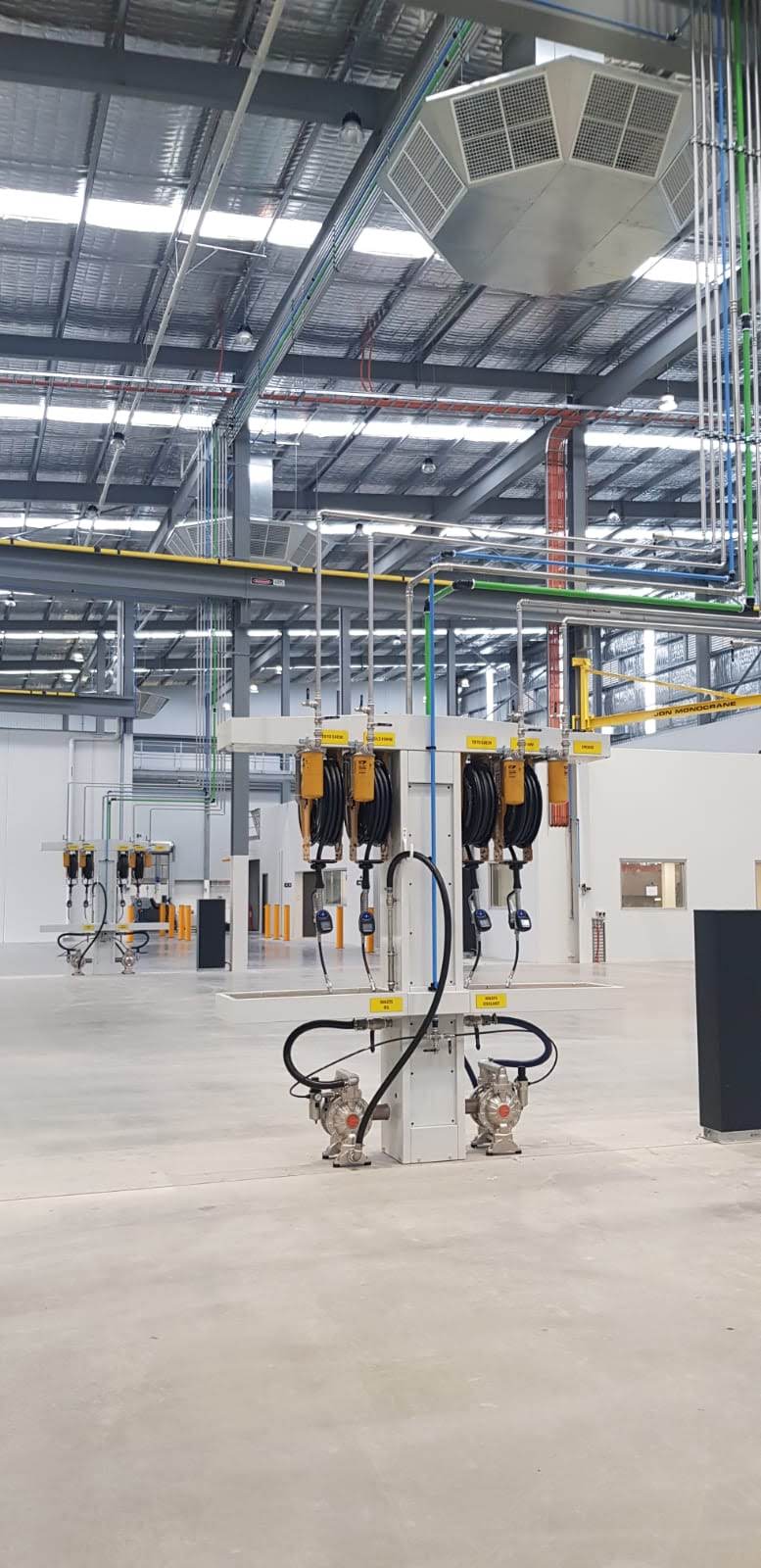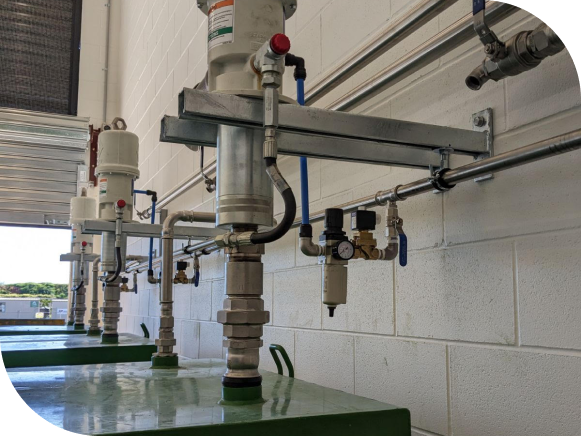We are well versed in the art of system design for high-pressure oil supply pipework from storage vessels (IBC/Palletcon or custom made tanks, including bunded tanks) to point of use including multi-service gantries, hose reels, metered oil delivery nozzles and more. Complete system layout and implementation of software-rich service/fluid delivery processes are some of the ways Airquip can help deliver higher efficiency and greater transparency/accountability across your workshop operations.
Grease supply pipework is with high pressure steel compression pipe systems designed to withstand the extreme pressures of fluid with an adequate safety factor to minimise liability. We don’t play around with inferior products or substandard installation procedures. The dangers related to whiplash and hydraulic injection injury are very real, so our team do what it takes to deliver a safe and compliant system.

Pressurised oil pipework systems utilising stainless steel crimped fittings and pipes offer a robust and efficient solution for various industrial applications. These systems, designed to comply with Australian Standards, ensure both safety and reliability in oil delivery processes. Adherence to relevant Australian Standards is paramount in guaranteeing the integrity and safety of the oil pipework infrastructure.
The utilisation of stainless steel pipework with crimped fittings not only ensures corrosion resistance and longevity but also provides a fast, secure, and leak-free connection, minimising the risk of oil leaks and environmental contamination. Moreover, compliance with Australian Standards encompasses proper design, installation, and maintenance practices, ensuring that the system operates within specified parameters and mitigates potential hazards associated with pressurised oil delivery.
In addition to safety considerations, it is imperative to address the issue of overpressure relief due to thermal expansion and contraction within the pipework system. Thermal fluctuations can lead to pressure buildup, posing a risk of system failure or rupture. Implementing overpressure relief mechanisms, such as pressure relief valves or expansion joints, helps safeguard the system by releasing excess pressure and preventing damage caused by thermal movement.
Furthermore, the advantages of a reticulated oil delivery system over traditional methods, such as drums or decanting at the point of use, are significant. Reticulated systems offer a continuous and reliable supply of oil directly to the point of use, eliminating the need for manual handling of heavy drums and the associated risks of spills, contamination, and worker injuries. Additionally, centralised oil delivery systems streamline workflow, reduce downtime, and enhance productivity by ensuring consistent oil availability without interruptions or delays. Some systems can be integrated with an existing ERP and can offer great security and accountability features.
In conclusion, pressurised oil pipework systems utilizing stainless steel crimped fittings and pipes, when designed and installed in compliance with Australian Standards, provide a safe, reliable, and efficient solution for oil delivery in industrial settings. By addressing safety concerns, implementing overpressure relief measures, and leveraging the advantages of reticulated oil delivery systems, businesses can optimise their operations, minimise risks, and enhance overall productivity.

High-pressure grease pipework systems are crucial components in industrial machinery maintenance, ensuring efficient lubrication to extend equipment lifespan and minimise downtime. Safety is paramount in these systems, particularly concerning the prevention of risks associated with hydraulic penetration injuries. Rigorous adherence to safety protocols and industry standards is essential. Employing safety features like high-pressure relief valves and pressure gauges helps to mitigate the risk of overpressurisation and potential hydraulic injection injuries. Additionally, implementing comprehensive training programs for personnel handling the grease pipework systems ensures proper usage, maintenance, and emergency response protocols, reducing the likelihood of accidents and injuries.
A properly installed pipeline for grease delivery to the point of use can significantly enhance the efficiency and productivity of a workshop. Firstly, such a pipeline eliminates the need for manual handling of grease containers, such as drums or cartridges, reducing labour time and minimising the risk of worker injuries associated with heavy lifting and repetitive strain. By streamlining the delivery process, workers can focus their time and energy on core tasks, ultimately increasing overall productivity within the workshop.
Moreover, a well-designed grease pipeline ensures consistent and reliable grease delivery to each point of use throughout the workshop. This consistency eliminates the downtime associated with waiting for grease refills or troubleshooting issues related to inadequate lubrication. As a result, machinery and equipment can operate at optimal performance levels, reducing the likelihood of breakdowns and costly repairs. Additionally, the continuous supply of grease minimises the risk of equipment wear and tear, prolonging the lifespan of critical machinery and reducing maintenance requirements in the long run. Overall, a properly installed grease pipeline not only improves workflow efficiency but also contributes to cost savings and enhances the overall operational effectiveness of the workshop.

Copyright © 2025 airquippipetool | All rights reserved